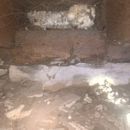Closed-cell spray foam in crawlspace for encapsulation
Some of you might have seen my other posts and know that I’m currently in a mad dash to encapsulate this crawlspace before moving in next week.
Situation:
-1869 Farmhouse
-shallow crawlspace (never vented)
-Crawlspace contains no ductwork or appliances (mini splits)
-Balloon Framing with area between crawl and living space sealed already
-Nasty stuff in crawlspace removed, but remnants without question (bad stuff)
Plan:
-6 Mil poly sheet over dirt for vapor barrier (to be replaced with heavier later)
-air seal floor joists with OSB or Poly-Iso (to assist with keeping out “bad stuff”)
-Spray 2″ Closed Cell over rim joist and rubble stone foundation
-Exhaust from exterior crawlspace wall and install adequate vent in sub-floor
Problem:
-My friend who sprayed the whole house with 3″ closed cell foam has told me that the thinks spraying this wood and stone (shown in picture) with closed cell will rot the wood. This house sits practically at grade.
-If he’s wrong, would the poly sheet run up the vertical surface before or after spraying?
GBA Detail Library
A collection of one thousand construction details organized by climate and house part










Replies
Is the “bad stuff” in or on the ground on the floor of the crawlspace? If it is (which I’m assuming is the case) the polyethylene liner will seal the “bad stuff” off from the conditioned space so you won’t need a second air barrier on the joists.
What is on the exterior of the wall? Is it something vapor permeable? Ideally you want there to be some drying potential in at least one direction closed cell spray foam isn’t really going to allow any drying, so you want the wall to be able to try to the exterior. If you have something on the exterior that is not vapor permeable, then using something that is vapor permeable on the inside is a little safer.
In my own crawlspace, I have foil faced polyiso on the exterior, so I foamed in pieces of EPS on the inside of the rimjoist to insulate it in a way that still allowed some drying.
Your other issue is capillary draw up the foundation wall to the level of the wood. Covering the wall with poly sheeting or spray foam reduces drying potential and increases the risk of rot with wood that isn’t protected by a capillary break. Some dimple mat against the wall to allow for some air movement may help with that.
Bill
Thank you Bill. I was with you all the way until the last sentence. I can use a mat against the wall to allow for air movement?
The "bad stuff" was everywhere haha. All different kinds of bad stuff. Pretty much everything you don't want to find in an old crawlspace. All since removed, but would prefer to take every step possible to prevent it's tiny remnants in the living space.
Sorry about that, autocorrect (I’m posting from my phone) changed “dimple” to “simple”. That should have read “some dimple mat against the wall”, and edited my original comment to fix the typo.
A dimple mat will provide about a 1/4” of air gap to help the wall dry which may help you a little with potential rot issues. You could put the dimple mat against the wall, caulk the top to seal the gap, then tape the polyethylene sheet on the floor to the bottom edge of the dimple mat. Rigid foam could then go over the dimple mat. You’ll need a fairly flat wall for this to work well. If the wall is stone, you might find that putting rigid foam right over the stone will actually create that small air gap you want between the insulation and the wall without the need for the dimple mat. It all depends on how rough the wall is.
Sometimes sealing the wood with a good primer sealer (like BIN) will help if you have smell as part of your “bad stuff”. BIN will make its own smell for a while though too, and you definitely want to wear a suitable respirator while working with BIN in a confined space.
Bill